| Look up weigh in Wiktionary, the free dictionary. |
To weigh something is to measure its weight.
Contents
Weigh may also refer to:
| Look up weigh in Wiktionary, the free dictionary. |
To weigh something is to measure its weight.
Weigh may also refer to:
Weigh anchor is a nautical term indicating the final preparation of a sea vessel for getting underway.
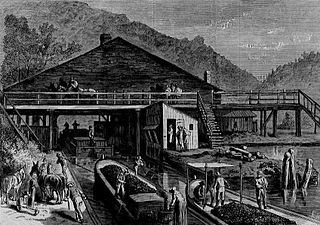
A weigh lock is a specialized canal lock designed to determine the weight of barges in order to assess toll payments based upon the weight and value of the cargo carried. This requires that the unladen weight of the barge be known.
Stephen Weigh is an Australian former professional basketball player who spent 10 seasons in the National Basketball League (NBL). He started his NBL career in 2008 after a two-year college stint at Utah. He won his only NBL Championship in 2010 with the Wildcats before joining the Adelaide 36ers in 2011. After two seasons with the 36ers, Weigh returned to his home state of Queensland and played out his final five seasons with the Cairns Taipans.
Weight classes are divisions of competition used to match competitors against others of their own size. Weight classes are used in a variety of sports, especially combat sports. Alternatives to formal weight classes include catch weight and openweight.

A Truck scale (US), weighbridge (non-US) or railroad scale is a large set of scales, usually mounted permanently on a concrete foundation, that is used to weigh entire rail or road vehicles and their contents. By weighing the vehicle both empty and when loaded, the load carried by the vehicle can be calculated.

A weigh house or weighing house is a public building at or within which goods are weighed. Most of these buildings were built before 1800, prior to the establishment of international standards for weights. As public control of the weight of goods was very important, they were run by local authorities who would also use them for the levying of taxes on goods transported through or sold within the city. Therefore, weigh houses would often be near a market square or town centre.
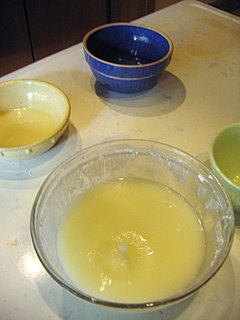
Whey is the liquid remaining after milk has been curdled and strained. It is a byproduct of the manufacture of cheese or casein and has several commercial uses. Sweet whey is a byproduct produced during the manufacture of rennet types of hard cheese, like Cheddar or Swiss cheese. Acid whey is a byproduct produced during the making of acid types of dairy products, such as cottage cheese or strained yogurt.
| This disambiguation page lists articles associated with the title Weigh. If an internal link led you here, you may wish to change the link to point directly to the intended article. |
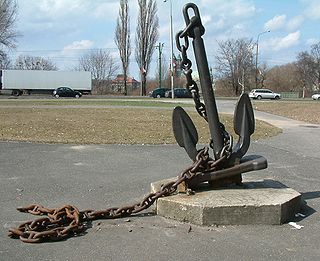
An anchor is a device, normally made of metal, used to connect a vessel to the bed of a body of water to prevent the craft from drifting due to wind or current. The word derives from Latin ancora, which itself comes from the Greek ἄγκυρα (ankura).
The ton is a unit of measure. It has a long history and has acquired a number of meanings and uses over the years. It is used principally as a unit of mass. Its original use as a measurement of volume has continued in the capacity of cargo ships and in terms such as the freight ton. It can also be used as a measure of energy, for truck classification, or as a colloquial term.

Olympic-style weightlifting, or Olympic weightlifting, often simply referred to as weightlifting, is an athletic discipline in the modern Olympic program in which the athlete attempts a maximum-weight single lift of a barbell loaded with weight plates.

Waterways in the United Kingdom is a link page for any waterway, river, canal, firth or estuary in the United Kingdom.
Reliability in statistics and psychometrics is the overall consistency of a measure. A measure is said to have a high reliability if it produces similar results under consistent conditions. "It is the characteristic of a set of test scores that relates to the amount of random error from the measurement process that might be embedded in the scores. Scores that are highly reliable are accurate, reproducible, and consistent from one testing occasion to another. That is, if the testing process were repeated with a group of test takers, essentially the same results would be obtained. Various kinds of reliability coefficients, with values ranging between 0.00 and 1.00, are usually used to indicate the amount of error in the scores." For example, measurements of people's height and weight are often extremely reliable.

A mooring refers to any permanent structure to which a vessel may be secured. Examples include quays, wharfs, jetties, piers, anchor buoys, and mooring buoys. A ship is secured to a mooring to forestall free movement of the ship on the water. An anchor mooring fixes a vessel's position relative to a point on the bottom of a waterway without connecting the vessel to shore. As a verb, mooring refers to the act of attaching a vessel to a mooring.
Tonnage is a measure of the cargo-carrying capacity of a ship. The term derives from the taxation paid on tuns or casks of wine. In modern maritime usage, "tonnage" specifically refers to a calculation of the volume or cargo volume of a ship. Tonnage should not be confused with displacement, which refers to the actual weight of the vessel. Tonnage is commonly used to assess fees on commercial shipping.
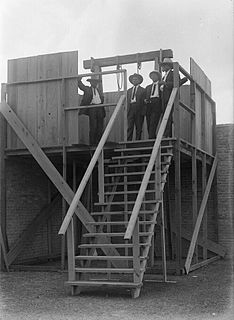
A gallows is a frame, typically wooden, from which objects can be hung or “weighed.” Gallows were thus widely used for public weighing scales for large objects such as sacks of grain or minerals, usually positioned in markets or toll gates. The term was also used for a framework from which an ship’s anchor might be raised so that it no longer sat on the bottom, i.e., “weighing [the] anchor.” In modern usage it has come to mean almost exclusively a scaffold or gibbet used for execution by hanging.
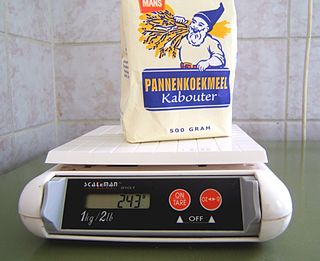
A weighing scale is a device to measure weight or mass. These are also known as mass scales, weight scales, mass balance, weight balance, or simply scale, balance, or balance scale.
Total suspended solids (TSS) is the dry-weight of suspended particles, that are not dissolved, in a sample of water that can be trapped by a filter that is analyzed using a filtration apparatus. It is a water quality parameter used to assess the quality of a specimen of any type of water or water body, ocean water for example, or wastewater after treatment in a wastewater treatment plant. It is listed as a conventional pollutant in the U.S. Clean Water Act. Total dissolved solids is another parameter acquired through a separate analysis which is also used to determine water quality based on the total substances that are fully dissolved within the water, rather than undissolved suspended particles.
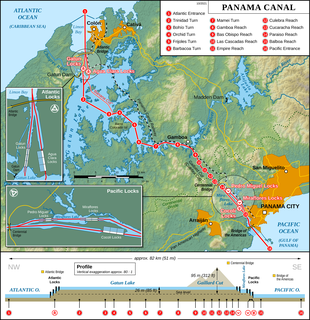
The Panama Canal locks are a lock system that lifts a ship up 85 feet to the main elevation of the Panama Canal and down again. The original canal had a total of six steps for a ship's passage. The total length of the lock structures, including the approach walls, is over 1.9 miles (3 km). The locks were one of the greatest engineering works ever to be undertaken when they opened in 1914. No other concrete construction of comparable size was undertaken until the Hoover Dam, in the 1930s.

The history of measurement systems in India begins in early Indus Valley Civilisation with the earliest surviving samples dated to the 5th millennium BCE. Since early times the adoption of standard weights and measures has reflected in the country's architectural, folk, and metallurgical artifacts. A complex system of weights and measures was adopted by the Maurya empire, which also formulated regulations for the usage of this system. Later, the Mughal empire (1526–1857) used standard measures to determine land holdings and collect land tax as a part of Mughal land reforms. The formal metrication in India is dated to 1st october 1958 when the Indian Government adopted the International System of Units (SI).
A checkweigher is an automatic or manual machine for checking the weight of packaged commodities. It is normally found at the offgoing end of a production process and is used to ensure that the weight of a pack of the commodity is within specified limits. Any packs that are outside the tolerance are taken out of line automatically.

A cathead is a large wooden beam located on either side of the bow of a sailing ship, and angled forward at roughly 45 degrees. The beam is used to support the ship's anchor when raising it or lowering it, and for carrying the anchor on its stock-end when suspended outside the ship's side. It is furnished with sheaves at the outer end, and the inner end fits down on the cat-beam. The cat stopper also fastens the anchor on. The purpose of the cathead is to provide both a heavy enough beam to support the massive weight of the anchor, and to hold the metal anchor away from the wooden side of the ship to prevent damage.
Ship measurements consist of a multitude of terms and definitions specifically related to ships and measuring or defining their characteristics.
The National Conference on Weights and Measures (NCWM) is a not-for-profit corporation dedicated to developing the United States technical standards for weights and measures in commerce. The organization's official mission is to advance a healthy business and consumer climate through the development and implementation of uniform and equitable weights and measures standards using a consensus building process.
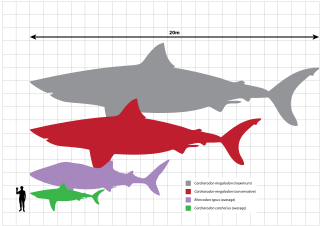
Size is the magnitude or dimensions of a thing. Size can be measured as length, width, height, diameter, perimeter, area, volume, or mass.